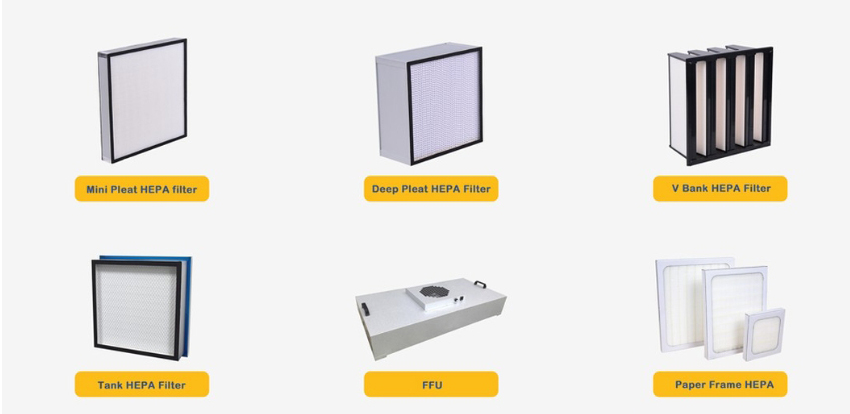 January 03, 2025
January 03, 2025
Semiconductor fabrication is one of the most intricate and precise manufacturing processes in the world. The components produced in this industry form the backbone of modern electronics, from smartphones and computers to medical devices and advanced automotive systems. To ensure flawless operation, semiconductor fabrication requires an ultra-clean environment where even the smallest particles can compromise product quality. This is where cleanroom filters come into play.
In this blog, we will delve into the critical role of cleanroom filters in semiconductor fabrication, explore the types of filters used, and highlight key considerations for selecting and maintaining these filters.

The Need for Pristine Cleanrooms
The production of semiconductors involves processes like photolithography, etching, and deposition, which require environments free of particulate matter, microbes, and chemical vapors. Even a single microscopic particle can cause defects in a semiconductor wafer, leading to reduced yields and compromised product reliability.
Contaminants to Combat
Cleanroom filters are designed to tackle a range of contaminants:
- Particulate matter: Dust, fibers, and skin flakes.
- Chemical vapors: Gaseous pollutants that can react with sensitive materials.
- Microbial contamination: Bacteria and fungi that can proliferate under certain conditions.
- Molecular contamination: Organic or inorganic molecules that can settle on surfaces and interfere with semiconductor processes.
1. HEPA Filters (High-Efficiency Particulate Air)
HEPA filters are a cornerstone of cleanroom filtration, capable of trapping 99.97% of particles as small as 0.3 microns. These filters are ideal for removing dust, pollen, and other fine particulates.
2. ULPA Filters (Ultra-Low Penetration Air)
For environments requiring even stricter particle control, ULPA filters provide filtration efficiency of 99.999% for particles down to 0.12 microns. They are particularly critical in ISO Class 1 and Class 2 cleanrooms.
3. Chemical Filters (Gas Phase Filters)
These filters use activated carbon or other adsorbents to remove chemical vapors and odors. In semiconductor fabs, chemical filters play a key role in managing airborne molecular contaminants (AMCs).
4. Pre-Filters
Installed upstream of HEPA or ULPA filters, pre-filters capture larger particles, extending the lifespan of primary filters and reducing maintenance costs.
5. Fan Filter Units (FFUs)
FFUs integrate fans and filters into a single unit, providing localized filtration and airflow control. They are often used in modular cleanroom designs.
1. Cleanroom Classification
The required ISO classification of the cleanroom dictates the filtration efficiency needed. For instance, an ISO Class 1 cleanroom demands ULPA filters, while ISO Class 5 cleanrooms can suffice with HEPA filters.
2. Airflow and Pressure Requirements
Proper airflow management ensures uniform distribution of clean air, while maintaining the correct pressure differential prevents unfiltered air from entering the cleanroom.
3. Contaminant Profile
Understanding the specific contaminants present in your processes helps in selecting the right combination of particulate and chemical filters.
4. Durability and Maintenance
Filters must withstand continuous operation in high-demand environments. Choosing durable filters with predictable maintenance schedules minimizes downtime and operational costs.
5. Energy Efficiency
Advanced filters with low resistance to airflow can significantly reduce energy consumption while maintaining high filtration performance.
1. Regular Monitoring and Testing
Routine checks ensure that filters maintain their efficiency. Particle counters and airflow meters can help detect performance drops early.
2. Scheduled Replacements
Filters have finite lifespans. Adhering to manufacturer-recommended replacement schedules prevents unexpected failures.
3. Proper Installation
Incorrectly installed filters can lead to bypass leakage, compromising cleanroom integrity. Always follow industry standards and guidelines.
4. Cleanroom Protocols
Strict protocols for gowning, cleaning, and material handling reduce the introduction of contaminants, extending filter life.
5. Environmental Controls
Maintaining stable temperature and humidity levels prevents conditions that could degrade filter performance.
Advanced Filtration Media
Innovations in filtration materials, such as nanofibers and electrospun membranes, offer enhanced efficiency and lower pressure drops.
Smart Monitoring Systems
IoT-enabled sensors allow real-time tracking of filter performance, enabling predictive maintenance and reducing downtime.
Sustainable Filtration Solutions
Eco-friendly filters made from recyclable materials or with extended lifespans are gaining traction as industries strive to minimize their environmental impact.
Conclusion
Cleanroom filters are indispensable in ensuring the success of semiconductor fabrication. By providing an ultra-clean environment, these filters safeguard the intricate processes that define high-tech manufacturing. Selecting the right filters, maintaining them properly, and staying abreast of technological advancements are essential steps in optimizing cleanroom performance and achieving manufacturing excellence.
Whether you’re designing a new cleanroom or upgrading an existing facility, understanding the role of cleanroom filters is crucial. Investing in high-quality filters not only enhances product yields but also solidifies your position in the competitive semiconductor market.
Are you ready to enhance your cleanroom’s filtration system? Contact us today to explore cutting-edge solutions tailored to your needs.

